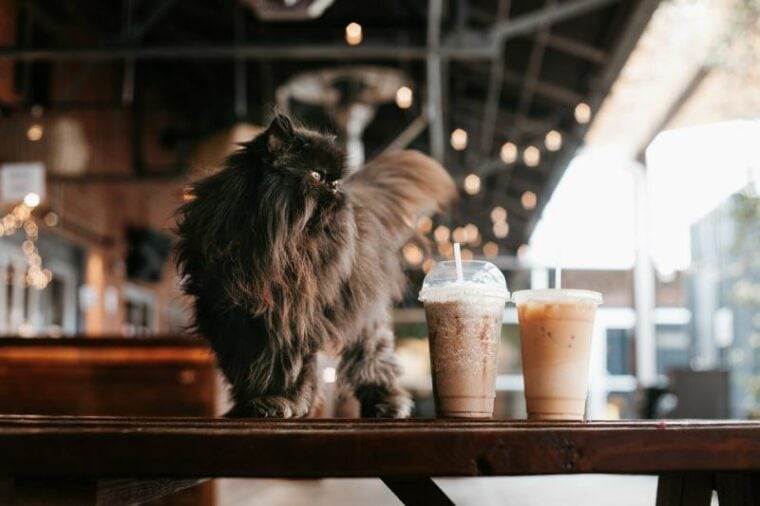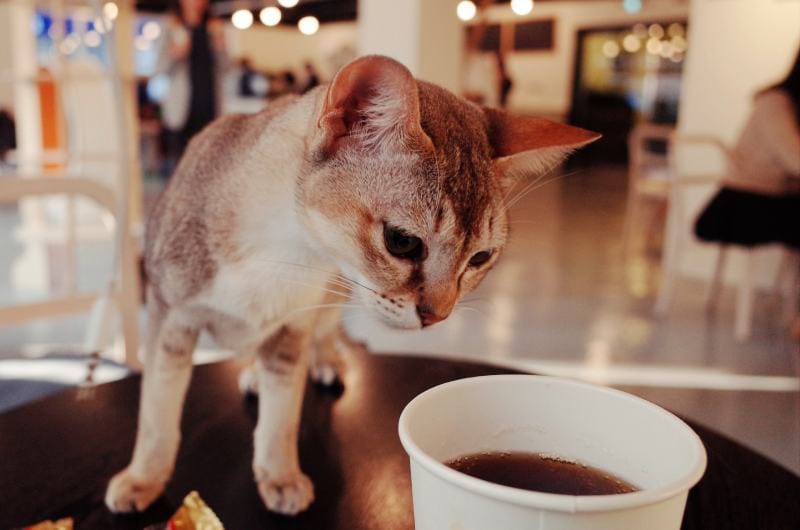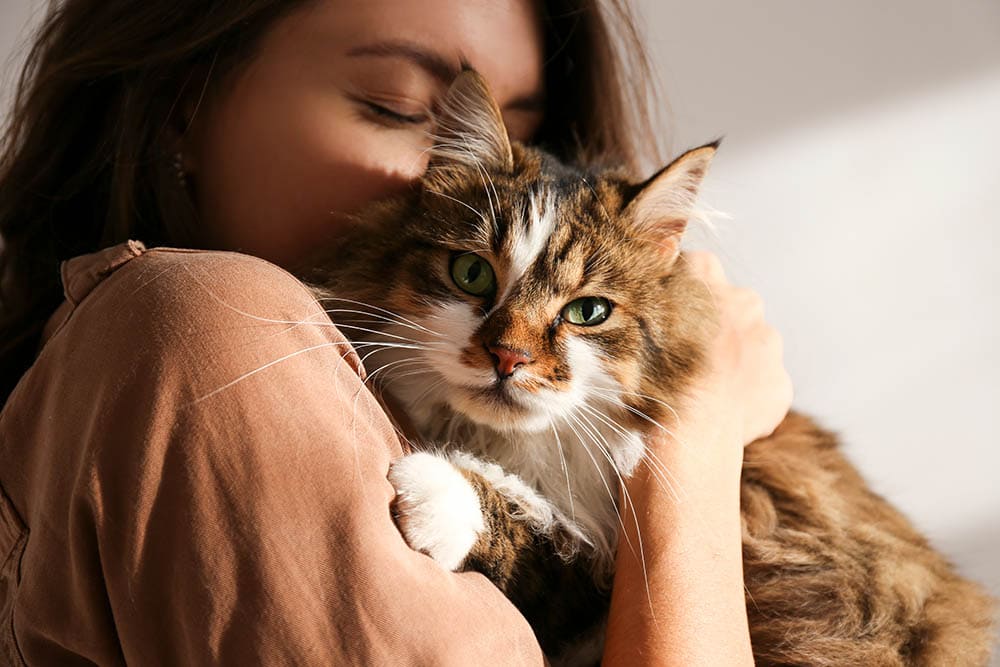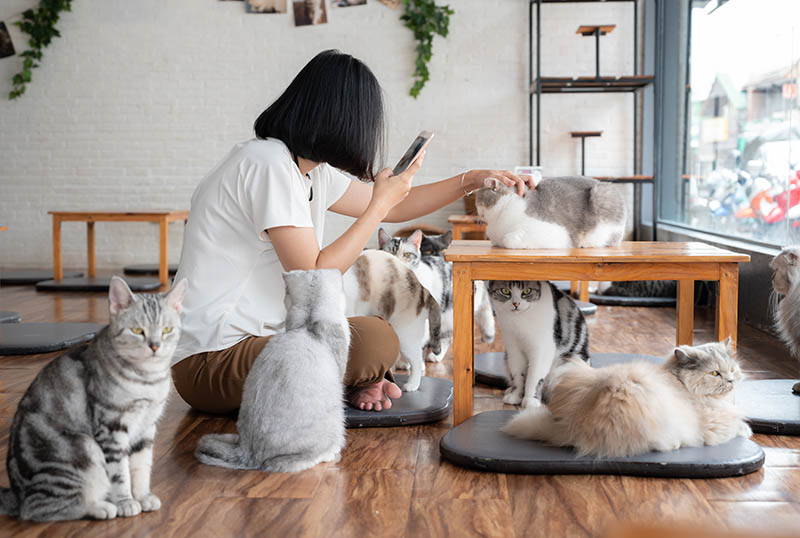
Imagine sipping a tasty latte on a cozy chair in a beautiful, welcoming café. Your beverage is at the perfect temperature, and the foam has the right consistency. The chair buckles slightly under your weight, just enough to envelope you in a comforting hug. The cats are head-butting your legs, begging for a pet to taste your freshly baked, buttery cinnamon roll.
Wait, cats? In a coffee shop?
Yes. Cats, caffeine, and desserts can finally coexist when you visit a cat café. It’s hard not to see the appeal of an establishment that revolves around the concept of snuggling cats and sipping coffee, but what made cat cafes such a popular business model? The success of cat cafés is generally due to the benefits people find while being around cats, especially those who cannot have one in their homes.
Keep reading to learn more about the history of these feline-focused coffee shops and learn what makes them such a hit.
When Did Cat Cafés Begin?
The first cat café, Cat Flower Garden, opened in Taipei, Taiwan, in 1998. But the concept of cat cafés didn’t really start to blossom until the cat-centric eateries reached Japan.
The first cat café in Japan—Neko no Jikan (Cat’s Time)—opened in Osaka in 2004. Tokyo’s first cat store—Neko no mise (Cat’s Store)—opened the following year. However, it was after 2005 when the popularity of cafés really exploded in the country. Over the next five years, 79 opened across Japan.
The United States didn’t get its first cat café until October 2014 in Oakland, California.

Why Did Cat Cafés Become So Popular?
Japan’s cat café boom could be due to many factors.
The popularity of the cat café business model could be tied to Japan’s iyashi (healing) boom. Iyashi is a label for things that are soothing, relaxing, and therapeutic psychologically and physically. The Japanese people found they could stop at a cat café at the end of a long day to decompress and relax.
In addition, Japanese citizens often don’t have the time, space, or experience to care for pets. Cafés provide the experience of visiting and playing with animals without the financial obligation, responsibility, or hassle of actually owning a pet.
Another potential reason for the popularity of cat cafés is the mental health improvements that can happen when people are around animals. Research suggests that almost ¾ of pet owners report having better mental health from pet ownership1. Furthermore, even one play or petting session with a cat can lower stress, anxiety, and even blood pressure2.
Japanese vs North American Cat Cafés
Though Japan has had a ten-year head start on cat cafés, the U.S. is catching up. At the time of writing, there are over 125 cafés in America, compared to 150 in Japan.
The concept of cat cafés differs between the two nations.
Having a pet in many areas of Japan is considered a luxury. Many people live in apartments, most of which are not pet-friendly. The concept of these Cafés is to give the visitors a chance to connect with a cat as they cannot have one of their own.
There are also countless types of cat Cafés throughout Japan. Some will house only specific types of cats, such as rare breeds, black cats, or the always popular fat cats.
In North America, however, cat cafés heavily focus on adoption. They often partner up with a local pet shelter to give visitors a chance to adopt the cats they interact with at the establishment.
Some cafés in North America also only focus on certain types of cats. For example, the Siberian Cat Café in Chelsea, Quebec, only has Siberian cats. This makes it unlike any other cat café in the world as it is hypoallergenic.

How Do Cat Cafés Work?
Cat café operations will differ slightly from establishment to establishment.
Most cafés operate on an hourly basis, charging customers for every hour they spend with the cats.
Some have two separate areas: one where they can serve food and drinks and the other where the cats are. Depending on the laws in the area, they can sometimes serve food in the same area as the pets. Some establishments even have a liquor license to serve cocktails and beer to their customers.
Are Cat Cafés Safe for the Cats?
Most well-run cat cafés provide the feline residents with a cozy and loving home. This doesn’t apply to all establishments, however.
Disease transmission is one of the biggest concerns with housing so many animals under one roof. One study found that some cats living in Japanese cat cafés tested positive for an internal parasite known as Giardia duodenalis. This parasite is contagious between cats and could even pass to humans.
There’s also the worry that the cats may get into trouble when the employees go home at the end of the day. With no human referee to stop fights, the resident cats may be at risk of injuries.

Conclusion
Cat cafés are a hit worldwide and don’t seem to be slowing down. It’s not hard to see how a business model revolving around cats could be anything but a success.
Everyone could stand to have a little furry friend in their lives. Unfortunately, pet ownership is not realistic for everyone. If one’s current lifestyle doesn’t allow for owning a pet, cat cafés are the perfect middle ground.
Featured Image Credit: Spike Summers, Pixabay






